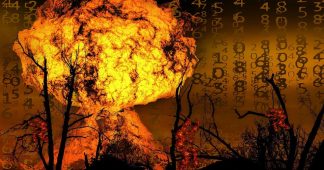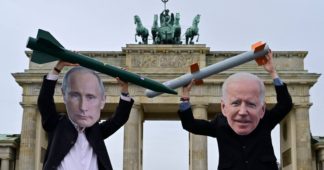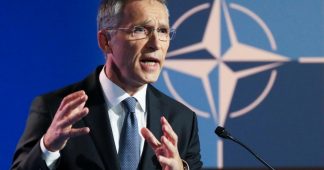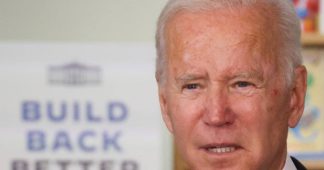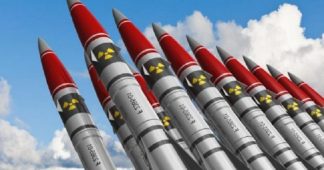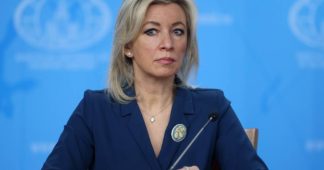It’s the anniversary of the atomic bombing of Hiroshima, and tensions between nuclear powers are spiking again. Citizen movements against nuclear weapons have always been crucial to avoiding nuclear war, and we need them as much as ever.
By David S. Meyer
Aug 6, 2024
Seventy-nine years after the United States dropped nuclear bombs on Hiroshima and Nagasaki, most of us rarely think about nuclear weapons. The oversight is understandable, but mistaken — and dangerous.
It’s understandable because while nuclear weapons are destructive and expensive, they seem like a distant risk. There are almost always more pressing or promising issues to attend to. But it’s dangerous to ignore them because an occasionally attentive public may be the main reason we’ve avoided a nuclear war thus far. Citizen movements against nuclear weapons during the Cold War helped significantly reduce nuclear risks. As global nuclear tension spikes again, we urgently need a renewed antinuclear movement.
Some dangers are glaringly obvious. Russia’s war in Ukraine continues, and Vladimir Putin periodically warns the world that Russia maintains a substantial nuclear arsenal. He’s also ordered his military to rehearse its use of tactical nuclear weapons. At the same time Israel, another nuclear nation, is fighting a lopsided war in Gaza and threatening to do whatever it takes to stop Iran from joining the nuclear club.
Meanwhile, the hard-won international arms control regime has all but collapsed. In 2019, both the United States and Russia abandoned the Intermediate-Range Nuclear Forces (INF) treaty that limited nuclear weapons in Europe. The New START agreements limiting long-range nuclear weapons are due to expire in 2026 as the United States, Russia, and China all invest in building up their strategic nuclear arsenals.
The United States has committed to an expensive plan to upgrade its nuclear arsenal, and Donald Trump’s team advocates the resumption of nuclear testing for the first time in more than thirty years. As Americans watch an ugly and divisive electoral campaign unfold, with many rights at risk, nuclear risks are rising as well.
People who pay attention to nuclear threats have been urging the rest of us to pay attention, too. In an effort to increase citizen awareness, they’ve written calls to action in The New York Times, the Washington Post, and the Los Angeles Times. The experts know that we need a modern peace movement to make a difference.
It could be worse: we could have never had such movements to begin with. Whenever they’ve appeared, strong popular movements against nuclear weapons have helped manage the risks and costs of the nuclear arms race. These movements are often edited out of the long and twisted history of the Cold War, but in reality, they focused politicians’ attention on nuclear danger and pressured them to reduce that danger. Activists involved in these movements haven’t gotten all they’ve wanted, but what they’ve achieved has changed the course of history.
The first campaigners against nuclear weapons were the scientists who made them. In 1945, in the wake of the bombings of Hiroshima and Nagasaki, scientists founded the Bulletin of the Atomic Scientists, which maintains a Doomsday Clock to illustrate the danger of nuclear apocalypse. The clock appeared in 1947, set at seven minutes to midnight, and scientists adjust it periodically in response to technical and political innovations. Arms control agreements, for example, result in added time. Right now it’s set at 90 seconds to midnight — closer to apocalypse than ever.
Antinuclear activism grew globally in response to destructive nuclear testing in the 1950s. A broad social movement captured the public imagination with tactics like sermons, educational programs, demonstrations, and civil disobedience. Dorothy Day, already on the road to sainthood, was arrested in 1955 for refusing to participate in a civil defense drill in New York City. Benjamin Spock, America’s baby doctor, appeared in newspaper ads announcing his alarm about radioactive isotypes found in baby teeth. Nobel Prize–winning chemist Linus Pauling picketed outside the White House the day before attending a dinner for Nobel winners inside. Pauling’s antinuclear efforts won him his second Nobel — this one for peace.
The movement provided impetus and incentives for John F. Kennedy’s administration to negotiate the end to atmospheric testing of nuclear weapons. Though it did not end the arms race, the Test Ban Treaty restrained nuclear testing. Later campaigns against antiballistic missiles pressured Richard Nixon to negotiate arms control treaties with the Soviet Union in the 1970s, which helped manage the danger and costs of the arms race and the Cold War.
The antinuclear movement also played a significant role in the 1980s. Fronting an expensive and aggressive campaign to put nuclear weapons in Europe, Ronald Reagan and other Western leaders faced mass opposition in Europe and a vigorous nuclear freeze campaign in the United States. In 1982, millions of people marched in Western European capitals against nuclear weapons. One million assembled in Central Park to support the freeze — and to attend concerts by Bruce Springsteen, Linda Ronstadt, and other musicians who threw their weight behind the cause.
Reagan responded to the politics of the movement and the moment, tempering his administration’s rhetoric about winnable nuclear wars and floating arms control proposals. When the new Soviet leader Mikhail Gorbachev accepted those proposals, the movement’s prime target became a born-again arms controller. As nuclear spending and the sense of danger declined, the movement faded from view. The INF and START treaties gave the Soviet Union the incentive and the space to begin to unwind the Cold War. The world’s nuclear arsenals declined from more than seventy thousand warheads to about twelve thousand today.
The steep reduction should not put our minds completely at ease, but it does offer evidence that peace movements work. When organized around possible and reasonable demands (“Freeze the Arms Race,” “Ban the Bomb”), they educate and engage ordinary people who put pressure on their leaders by marching, lobbying legislators, writing letters, getting arrested, and voting. There’s not one single magic tactic, but when a lot is going on at once, politicians pay attention.
Politicians respond to organized activism — not just elections. President Dwight D. Eisenhower put it best when he said, “People, in the long run, are going to do more to promote peace than our governments. . . . People want peace so much that one of these days governments had better get out of the way and let them have it.”
Activism props up the guardrails restraining the arms race. Those guardrails, teetering under pressure from all sides, need reinforcement now before it’s too late. And protest movements once again need to play a critical role.
We remind our readers that publication of articles on our site does not mean that we agree with what is written. Our policy is to publish anything which we consider of interest, so as to assist our readers in forming their opinions. Sometimes we even publish articles with which we totally disagree, since we believe it is important for our readers to be informed on as wide a spectrum of views as possible.
